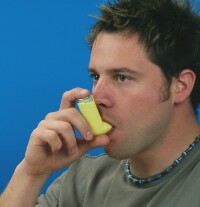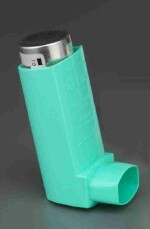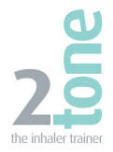1. The creation of an aerosol from the rapidly evaporating liquid results in cooling of the canister. This cooling can, in theory, mean the inhaler doesn't perform properly (they work best at room temperature).
2. Fast acting drugs that relieve bronchospasm can help open up the airways very quickly, allowing a second dose (if needed) to reach the furthest parts of the lung more easily.
The pressurised Metered Dose Inhaler (pMDI, or "puffer") is the most commonly used inhaler device, due to its simple design, low cost and reliable performance when used correctly.
There are two recommended ways to use a PMDI, the difference being whether you place the inhaler in your mouth to use it ("closed mouth technique"), or you activate it an inch or so in front of your mouth ("open mouth" or "two fingers" technique).
Otherwise both techniques are identical, and aim to maximise the amount of drug getting into the lungs, but minimise the amount that settles in the mouth, or hits the back of the throat.
1. Remove cap. Check mouthpiece is clear.
2. Shake inhaler well.
3. Hold inhaler upright with thumb on the base, below the mouthpiece.
4. Gently breathe out, as much as possible.
5. Place inhaler in your mouth and grip gently between the teeth. Make sure your tongue is underneath the inhaler, then seal your lips around the mouthpiece.
6. Start to inhale - slowly and deeply - then press the canister to release the aerosol. Keep on breathing in slowly until your lungs are full.
7. Hold your breath for a count of 10 (or as long as is comfortable). You can remove the inhaler from your mouth.
8. Breathe out slowly.
9. Breathe normally. Wait 30 seconds if you need to use the inhaler again.
10. Replace cap to keep out dust and fluff.


Open Mouth / "Two Fingers" Technique
1. Remove the mouthpiece cover.
2. Shake the inhaler.
3. Hold the inhaler upright, with your finger on the canister, and thumb underneath. Breathe out as far as is comfortable.
4. Place the mouthpiece approximately two fingers distance in front of your open mouth. Keep your tongue on the bottom of your mouth.
5. Start to breath in slowly and deeply, then press the canister down with your finger - continue to breathe in slowly until you have filled your lungs.
6. Hold the breath in for 10 seconds, or as long as is comfortable (you can remove the inhaler from your mouth, as long as you don't breathe out too early).
7. Breathe out slowly.
If you need to take a further dose, then wait several seconds before repeating steps 2 to 7.
Replace the mouthpiece cover
Animation of Closed Mouth Technique
"How to get the most from your Metered Dose Inhaler"
But if the pMDI is stored in a handbag, briefcase or somewhere else, it is a good idea before you use it to check that the mouthpiece is clean, and there is nothing stuck inside.
There is no agreement from experts on this - both techniques have been shown to work well when the instructions are followed properly. The open mouth technique is recommended more frequently in the United States, but in the United Kingdom and Europe, more patients are recommended to place the inhaler directly in the mouth.
In theory, the extra distance between the inhaler and the back of the throat (open mouth technique) allows more evaporation of the propellant/drug mix before it has to turn through the sharp bend to travel down the windpipe (in a similar way that a "Spacer" can help). However, placing the mouthpiece directly in the mouth (closed mouth technique) means that all the aerosol created is ready to be inhaled - there is no risk that any misses the mouth.
Whichever technique is used, it is important to get all the steps right - failing to complete any one properly can significantly reduce the dose that gets to the lungs. Practising in front of a mirror is recommended for all users. If aerosol or "mist" can be seen leaking out from the top of the inhaler or from either side of the mouth, then a little more help should be requested from a healthcare professional, in order to improve overall inhaler technique.
Testing your inhaler ?
If your inhaler is new or it has not been used for a week or more, shake it well and release one puff into the air to make sure that it works.

